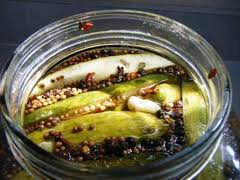| Back to Back Issues Page |
 |
|
Top 5 Fermented Food Q & A! -- Issue #022 October 17, 2011 |
~~~~~~~~~~~~~~~~~~~~~~~~~
~~~~~~~~~~~~~~~~~~~~~~~~~~
Top 5 Fermented Food Questions & AnswersIf you are new to the world of fermented foods and want to learn a little bit more about the process before you take on your first experiment, these five topics might be helpful to understanding the basics. The following is an excerpt taken from the new book "Cultured: Learn to Make Healthy Fermented Foods at Home!" The book is amazing!! I have been making some of these delicious cultured recipes in my own kitchen and wow are they good!
TOP 5 Fermented Food Questions
1) What’s the Difference Between Fermenting and Rotting? If the thought of eating fermented foods makes you a bit queasy, you’re not alone. There are indeed some people for whom the thought of eating anything more than a week old is simply gross. This is a frame of mind worth changing, however, as fermented foods are so far from the rotting foods that might be coming to mind for you. In simple terms, fermenting is great and safe, while rotting food is awful and downright dangerous! Although there is indeed a thin line between two processes, they couldn’t be more different in the results they produce. Let’s break down that distinction. Putrefaction is the process that causes food to rot, and when this occurs, harmful bacteria run amok on the food in question, breaking it down to an inedible and terribly stinky state. These bacteria rob your food of life. With fermentation, however, you’re exercising some degree control of the environment in which the food is placed; when this is done correctly, beneficial bacteria are produced that inhibit the growth of harmful bacteria. This preserves and infuses the food with beneficial bacteria, allowing you to eat it well past its usual shelf life. So if you’re worried that fermented foods have spoiled or rotted in any way, rest assured – fermentation has banished the bad bacteria that can make you sick, or at the very least, get your gag reflex going. 2) Do Bacteria Survive the Journey Past Your Stomach Acid? Despite how powerful stomach acid is, many bacteria do make it into the gut, which you’ll definitely understand should you take a trip to Mexico or India and mistakenly drink the water. Not good! This all largely depends on the strength of the strain of the bacteria in question, and it’s the strongest ones that make it through to help repopulate your gut. As such, it’s important to make sure the foods you’re eating have a wide variety of live, healthy, strong bacteria, which is one of the main reasons we prefer cultured ferments.
3) Finding the Right Temperature For Your Fermented Food… Fermentation is a delicate process, and it’s very important to be mindful of maintaining the right temperature in the area where you choose to let your ferments sit. I’ll give you an example: my wife Annmarie and I tried our hand at yogurt once. We were using a yogurt maker, which we figured would be pretty straightforward as it maintains a constant temperature of 90 degrees. Everything would have been fine had we not left the yogurt maker close to a window that let a steady stream of sunlight in. What we ended up with was most definitely not yogurt. This principle also applies if you’re living in a colder climate. If this the case, you’ll want to set your ferment in warmer area of the house, or else your ferment may not grow at all.
4) Fermentation Times – How Long Does It Take To Ferment Something? Here’s a tricky subject: how long should you let your ferments sit for? There’s no firm answer for this, but that’s all part of the fun. Effective fermentation times vary entirely based on how much prebiotic you add and what temperature your ferments maintain. With experience however, you’ll come to recognize this as an art, knowing what to look for and taste for. Of course, personal preferences come into play here as well. Many foods will have sufficiently fermented in the course of a week, but that time can be extended or reduced. For example, in the case of coconut kefir, you might like it very bubbly, which requires a longer fermentation time; less bubbly doesn’t need to sit as long. Similarly, most vegetables break down more and develop a stronger, more vinegary with time; as such, if you prefer milder flavors, you might not want to allow your ferment to sit as long. The best thing to do aside from consulting recipes is to taste your food at regular intervals, every 3 or 4 days. This will allow you to experience and understand the relationship between time the various stages of the fermentation process, in addition to allowing you to determine what kind of taste is pleasing to your taste buds. 5) Fermenting at Home Vs. Store-bought Ferments Just as we took a moment to consider why producing your own ferments was preferable to buying probiotic supplements, you should give some thought as to why fermenting at home would be preferable to buying ready-to-eat ferments from the grocery. Right off the bat, there’s an immediate advantage that shouldn’t require much consideration: it’s so much cheaper to do it yourself! Many things are cheaper DIY style, but this is especially the case with fermented foods, as many of them can very pricey. For example, I remember once buying a jar of sauerkraut from a store for about $9. This was the good stuff, sauerkraut that hadn’t been heated to pasteurize and “purify” it, allowing all of the beneficial bacteria to remain intact. I was quite pleased with my purchase until I came home and realized I could literally ferment almost four times that amount of sauerkraut for the same price with very little effort. Of course, if you’re buying fermented foods from your local farmer’s market, there’s a good chance that those are recipes that have been fine-tuned over hundreds of batches. That’s fine, and it shouldn’t discourage you from trying your own ferments at home. It allows you to support your local farmers and get an idea of the standards you can hope to achieve with practice. If you’re buying from a larger chain supermarket, try to look for information on the label about their fermentation practices. You definitely don’t want pasteurized ferments, as they won’t provide the health benefits that you’re seeking. If they don’t, however, and the rest of the information on the label checks out, feel free to give it a go. One advantage is that these foods will likely have been subject to extremely strict processing guidelines, giving you the assurance that the food you’re getting was prepared in a very hygienic setting.
NEW Fermented Foods Recipe BookAs discussed above, one of the major things I've noticed over the years is that many people WANT to eat more fermented foods, but they DON'T WANT to pay all the money to buy them ready made in the store. I mean, have you seen the prices lately for commercial kombucha or sauerkraut brands? These foods and many others are easy and WAY cheaper to make yourself!Cultured: Learn to Make Healthy Fermented Foods at Home! is a one of a kind compilation of some of the best fermented food recipes including creatively colorful kefirs, yogurts, kimchees, misos, kombuchas, vegan cheeses, non-gluten breads, tempehs and many other cultured foods that you may not be familiar with. If you are at all interested in the subject or want to learn more about how to make fermented food recipes yourself, take a look at this great new resource! For more info click here. Recipe of the Month:Homemade Pickle Recipe
Want to know how to make pickles? Here is a crispy, crunchy pickle recipe taken from the the new book “Cultured: Learn To Make Healthy Fermented Foods at Home!” I tried it and its a good one!
Brine: 1/2 gallon of spring water with 6 tbsp sea salt dissolved into it Equipment: 1 gallon wide-mouthed glass jar (washed really well) Cheesecloth or mesh screen After collecting all your ingredients, wash your cucumbers and prepare them as needed. If you do not have small pickling cucumbers, you may use a larger size, but may need to cut them down in size. You can coin cut larger cukes or cut them into 3-4 inch spears. Do as you wish. Pack the cucumbers into the glass jar to fill it 3/4 full. Add to the brine your tannic leaves, any spices and as many different garden herbs as you wish. Pour in the brine to cover the cucumbers by at least 1 inch. Stir in your whey or probiotics. Cover the jar with cheese cloth. Allow to stand at room temperature for 3 days. Keep an eye on the cucumbers and give them an occasional push below the surface of the brine. Taste and check for texture and taste. Continue to let stand for a 2 days, then taste. Once desired taste is achieved, place in the fridge. Pickles will continue to ferment, slowly, and build flavor over time. Save some of the brine to inoculate your new batch of pickles. This recipe was Contributed by Frank Giglio (frankgiglio.com)
Until our next issue... May you thrive, prosper and evolve in the best of ways!
SUBSCRIBE TO OUR:
All information in this ezine is the personal view of the author and is for educational purposes only and not intended as medical advice, diagnosis or prescription. This information has not been evaluated by the FDA and is not intended to cure or prevent any disease.
|
| Back to Back Issues Page |






